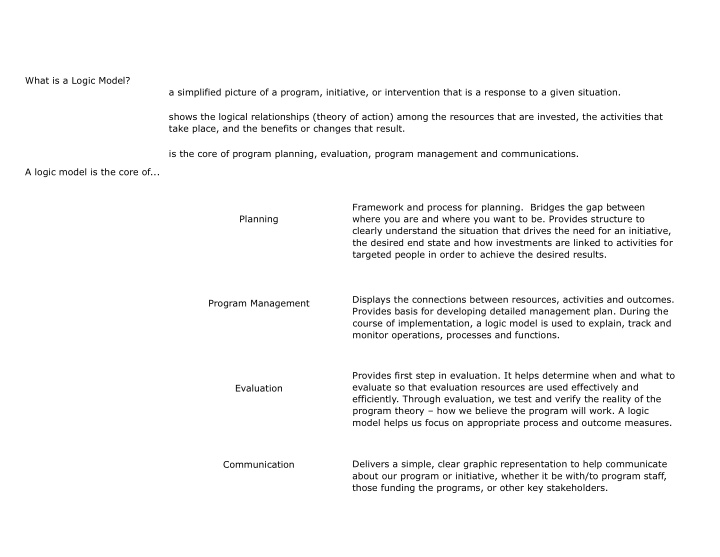



What is a Logic Model? a simplified picture of a program, initiative, or intervention that is a response to a given situation. shows the logical relationships (theory of action) among the resources that are invested, the activities that take place, and the benefits or changes that result. is the core of program planning, evaluation, program management and communications. A logic model is the core of... Framework and process for planning. Bridges the gap between Planning where you are and where you want to be. Provides structure to clearly understand the situation that drives the need for an initiative, the desired end state and how investments are linked to activities for targeted people in order to achieve the desired results. Displays the connections between resources, activities and outcomes. Program Management Provides basis for developing detailed management plan. During the course of implementation, a logic model is used to explain, track and monitor operations, processes and functions. Provides first step in evaluation. It helps determine when and what to evaluate so that evaluation resources are used effectively and Evaluation efficiently. Through evaluation, we test and verify the reality of the program theory – how we believe the program will work. A logic model helps us focus on appropriate process and outcome measures. Delivers a simple, clear graphic representation to help communicate Communication about our program or initiative, whether it be with/to program staff, those funding the programs, or other key stakeholders.
What it looks like: Logical Relationship Between Resources, Activities, and Results
1. Situation & Priorities What is the problem/issue? Why is this a problem? (What causes the problem?) For whom (individual, household, group, community, society in general) does this problem exist? Who has a stake in the problem? (Who cares whether it is resolved or not?) What do we know about the problem/issue/people that are involved? What research, experience do we have? What do existing research and experience say? What criteria will you use for setting priorities? Who will help in setting priorities? 2. Inputs What resources and contributions will you and others make to the effort? These include time, people (staff, volunteers), money, materials, equipment, partnerships, research base, and technology among other things. 3. Outputs What activities, services, events, and products will we deliver to reach people (individuals, groups, agencies) who participate or who are targeted? 4. Outcomes What are the direct results or benefits for individuals, families, groups, communities, organizations, or systems? Examples include changes in knowledge, skill development, changes in behavior, capacities or decision-making, policy development. Outcomes can be short-term, medium-term, or longer-term achievements. Outcomes may be positive, negative, neutral, intended, or unintended. 5. Assumptions What assumptions and beliefs do we have about the program, the people involved, and the way we think the program will work. This is the "theory" we are talking about: the underlying beliefs in how it will work. These are validated with research and experience. Assumptions underlie and influence the program decisions we make. 6. External Factors What external factors can influence the program's success? (community climate, economic conditions, demographic patterns, political environment, background and experiences of program participants, media influence, changing policies and priorities.
Why Use the Logic Model? How will it help you? The logic model: Brings detail to broad goals; helps in planning, evaluation, implementation, and communications. Helps to identify gaps in our program logic and clarifies assumptions so success may be more likely. Builds understanding and promotes consensus about what the program is and how it will work--builds buy-in and teamwork. Makes underlying beliefs explicit. Helps to clarify what is appropriate to evaluate, and when, so that evaluation resources are used wisely. Summarizes complex programs to communicate with stakeholders, funders, audiences. Enables effective competition for resources. (Many funders request logic models in their grant requests.)
Let's Try It…Backwards
Recommend
More recommend